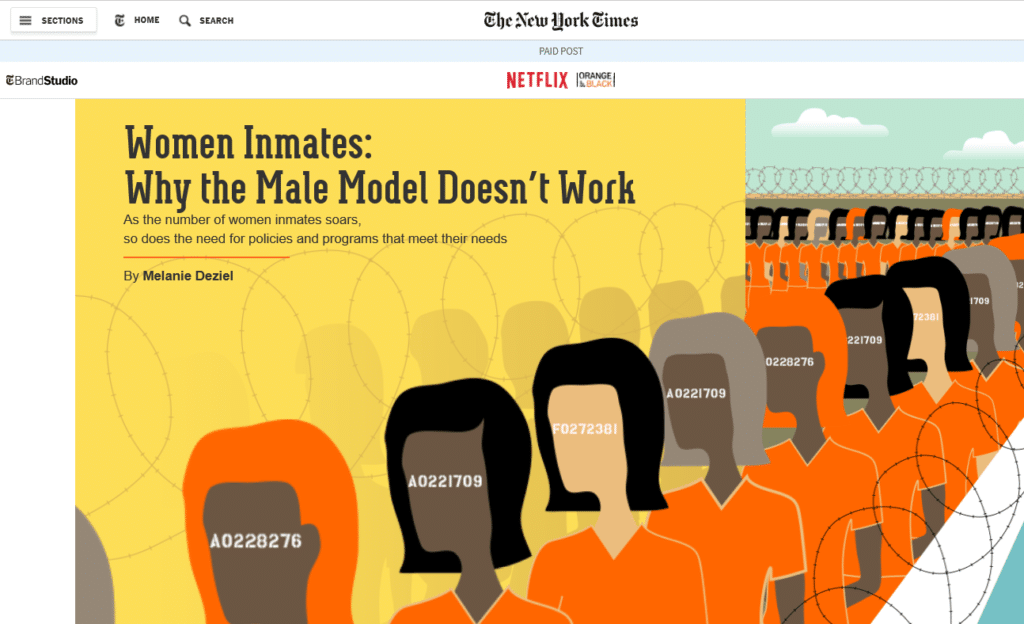At this point, modern consumers have encountered so many banner ads and similar types of advertising that they’ve learned to automatically tune them out when surfing the web.
As a result, today’s digital marketers have had to come up with smoother ways to get through to their target audiences, and sponsored content is an incredibly effective example.
However, as with every aspect of a well-crafted content marketing campaign, it’s crucial to understand the nuts and bolts of what helps a piece of sponsored content succeed. Read on for an in-depth look at everything you need to start.
- What Is Sponsored Content?
- How Does Sponsored Content Work?
- Do You Need to Disclose Sponsored Content?
- How Is Sponsored Content Different from Other Types of Paid Content?
- What Are the Benefits of Sponsored Content?
- How to Create Effective Sponsored Content
- Examples of Great Sponsored Content
- What Is the Future of Sponsored Content?
- Conclusion
Download this post by entering your email below
What Is Sponsored Content?
Sponsored content is a form of paid content designed to market, advertise, or promote a particular brand.
Sponsored blog posts are among its most common types. However, many brands also find success with sponsored videos, infographics, social media posts, events, and more.
How Does Sponsored Content Work?
In some cases, the brand that sponsors the content may create it in-house.
However, it’s much more common for sponsors to outsource the production to professionals or pay the publishing entity to do it on their behalf (as with influencer marketing partnerships).
A piece of sponsored content is an advertisement, but it can also be a valuable piece of branded content in its own right. According to research, consumers tend to remember branded content nearly twice as long as they recall ordinary content.
It can also be a valuable part of a brand’s ongoing social media strategy. For example, you can market LinkedIn sponsored content to your existing followers via your standard feed.
However, it can also be distributed to a larger audience through the platform’s campaign manager.
The process works similarly on other social media platforms like Instagram, Facebook, and Twitter. Sponsors can create posts using the advertising tools available to them. But many also have terrific luck partnering with influencers who have already established audiences.
Do You Need to Disclose Sponsored Content?
As with other types of content, a sponsored post’s success relies on its ability to inform, entertain, or inspire a reader.
But the Federal Trade Commission (FTC) still requires it to be marked as such so that it doesn’t mislead consumers. This is typically done by adding a special caption, hashtag, or another label.
Without proper disclosure, a creator risks landing in hot water with the FTC as well as their publishing platform. They also risk damaging their reputation and relationships with consumers.
How Is Sponsored Content Different from Other Types of Paid Content?
With so many different advertising options available, many digital marketers choose to mix sponsored content with other similar types of paid advertising, especially advertorials and native advertising. Here’s a look at the key differences to know.
Sponsored content vs. advertorials
Advertorials are easily confused with sponsored content; both are designed to seamlessly blend in with the rest of a publisher’s content.
However, advertorials are strictly advertisements that revolve around promoting the associated brand or product. On the other hand, sponsored content is reader-focused and seeks to address the audience’s needs.
The tone is also different. An advertorial will typically use very persuasive, salesy language to help convince a reader to buy something. But sponsored content is friendlier and lighter. It aims to make a meaningful connection with the reader.
Sponsored content vs. native advertising
Native ads are virtually identical to traditional ads regarding format and approach. However, like advertorials, they’re designed in a way that makes them blend in perfectly with the surrounding content. The ads you see on SERPs and in social media feeds are perfect examples of native advertising in action.
That said, the most obvious difference between sponsored content and native advertising is the format. However, native ads are always produced by the companies and brands being advertised.
Sponsored content may also be created in this way, but it’s just as likely to be produced by an influencer or other publisher.
What Are the Benefits of Sponsored Content?
Adding sponsored content to a digital marketing strategy carries many benefits for a brand manager or business owner. It can benefit the sponsor’s partners as well. Here’s a closer look at how.
Improved reach
It enables brands to leverage the established following of an influencer or publisher to reach new demographics. Posting about a popular brand can also help drive traffic to the publisher.
Promotes effective storytelling
Most people absorb so much information each day that they quickly forget one-off ads with no authentic relevance to their lives. However, people are hardwired to remember and respond to stories.
Successful sponsored content typically plays into the larger story behind a brand.
Builds stronger relationships
Most partnerships between brands and publishers are not only ongoing but mutually beneficial, so this type of content is excellent for networking. It’s also a powerful way for both brands and publishers to build better relationships with an audience.
Boosts credibility
Audiences know it takes trust for a brand and a publisher to enter into a sponsorship together. For that reason, sponsored content can improve the credibility of both entities in the eyes of an audience.
How to Create Effective Sponsored Content
Are you ready to start creating amazing sponsored content that enchants audiences and drives results? Here are some best practices and key tips to get you started in the right direction.
Know your audience
Whether you’re planning sponsored content for social media or looking to have something published by a standalone website or publication, it’s essential to know your target audience.
Who are they, where do they hang out online, and how do they prefer to consume their content?
You’ll also want to consider the audience’s unique pain points, values, and preferences. How can you design your content to connect with those particular people?
Choose the right partners
Not all partnerships are equal. Savvy marketers choose publications, influencers, and partners whose audiences are likely to be interested in the sponsoring brand and its products.
For example, culinary brands pair best with food bloggers and publications, beauty brands with style and beauty influencers, and so on.
Prioritize user experience
User experience is everything when it comes to any type of marketing content. Not only is it the best way to connect with an audience, but it’s also the best bet for your SEO strategy. Format your sponsored content with this in mind.
Also, ensure that your preferred host site is fast, organized, and capable of providing a positive experience for those interested in your content.
It should contain plenty of material that will make for solid further reading as well.
Obey labeling protocol
Remember, you don’t want to attempt to pass it off as ordinary content. This can get you into trouble and ruin the trust you’ve worked so hard to build with your target audience.
Use data to enhance your efforts
Amazing content that drives real results doesn’t just happen. It’s the result of deep research and reliable data, so it’s important to leverage such data when planning sponsored content.
Your content will be more effective if you plan it using market research, social media metrics, and first-party data that you’ve collected yourself.
Tracking the results of each new sponsored content campaign also helps you make future efforts stronger.
Examples of Great Sponsored Content
Of course, nothing drives home the idea of what makes sponsored content great quite like a few samples of successful campaigns in action. Here are a couple of examples to consider.
Michelob Ultra
This Instagram video from Tastemade was sponsored by Michelob Ultra and showcased a creative way that the beer can be used to cook something delicious—shrimp ceviche tostadas.
Not only did it demonstrate the versatility of the product, but it was genuinely helpful and potentially entertaining to Tastemade’s audience.
Netflix

This incredible sponsored article published by The New York Times was actually sponsored by Netflix to promote their iconic series Orange Is the New Black. However, it is also terrific content in its own right that offers value and entertainment for readers.
What Is the Future of Sponsored Content?
According to native advertising company AdYouLike, branded content (sponsored content included) is expected to become five times bigger by 2025. So digital marketers who get on board now can expect to ride that wave all the way to their own future success.
As social media and personalized content experiences continue to gain popularity, marketers can also expect trends like influencer marketing and customized interactive content to become more significant parts of how advertisers approach sponsorships.
Conclusion
As you can see, sponsored content can be a wonderful and highly effective way to build your brand identity and connect with potential new members of your growing target audience.
But it’s important to ensure you have a reliable team of expert content creators at your disposal, putting their skills and expertise to work for you every day.
Build your future dream team of content creation professionals today when you sign up for a 14-day free trial of WriterAccess!
WriterAccess is home to some of the best, most widely trusted content creators in the business, and they can work their magic for you, too.








